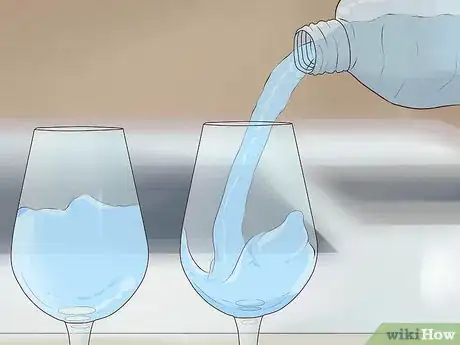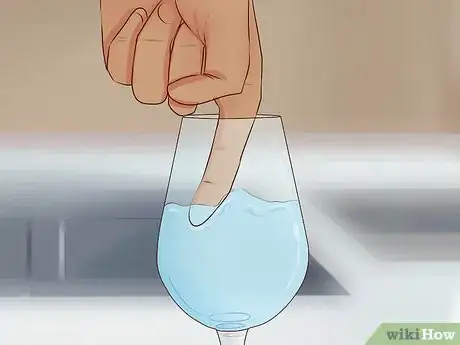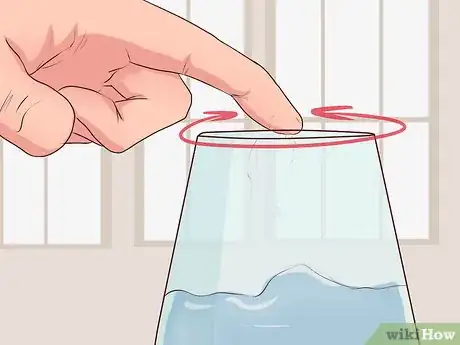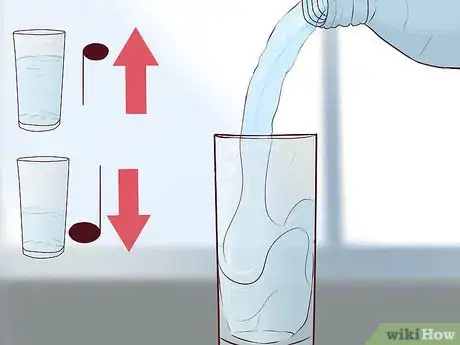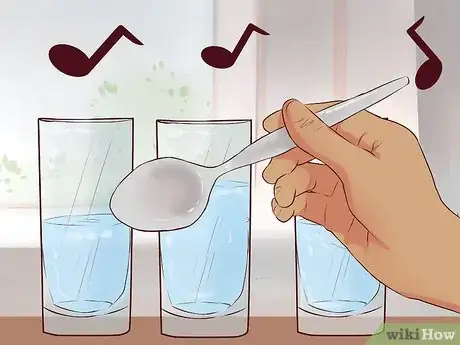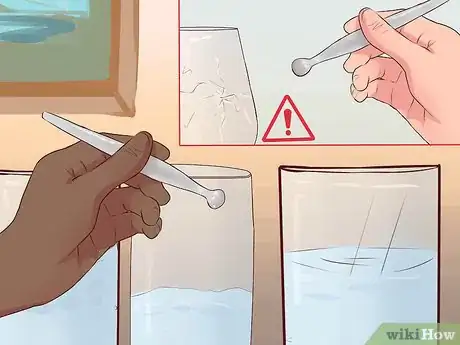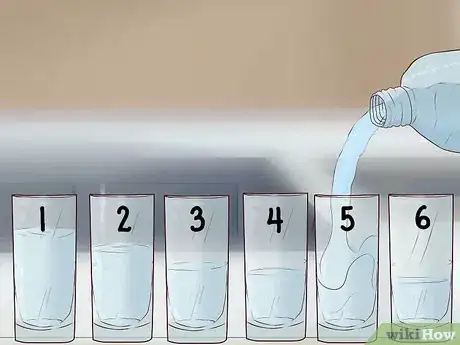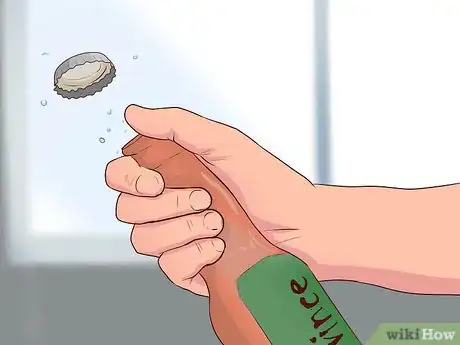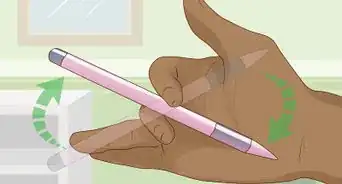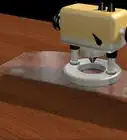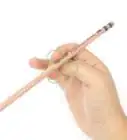This article was co-authored by wikiHow Staff. Our trained team of editors and researchers validate articles for accuracy and comprehensiveness. wikiHow's Content Management Team carefully monitors the work from our editorial staff to ensure that each article is backed by trusted research and meets our high quality standards.
There are 8 references cited in this article, which can be found at the bottom of the page.
This article has been viewed 99,348 times.
Learn more...
You've often seen somebody on TV or in a movie passing his or her finger through the border of a wine glass, producing a high-pitched noise. This is no trick! In fact, you can make a produce a variety of pleasant music using only a few different types of glasses, some water, and a little rhythm.
Steps
Making a Wine Glass Sing
-
1Fill a wine glass with water. The amount of water you place in the glass will affect the pitch of the sound that is created. The more water placed in the glass, the lower-pitched the sound. Conversely, the less water placed in the glass, the higher-pitch the sound.
- You may use other types of liquid in your wine glass to make music, but note that thicker liquids have a harder time creating music, and may alter the sound produced.[1]
-
2Dip your finger in the water. In order to create the friction needed to produce the “song,” your finger will need to be wet. This removes some of the oils from your fingers, allowing your finger to get the right “grip” on the glass rim.[2]
- Wash our hands prior to dipping your finger in the water to attain an especially oil-free finger.
- Dipping your finger in vinegar is also an effective way of clearing your finger of oils.
Advertisement -
3Run your finger along the rim of the glass. While holding the glass from the bottom with your other hand, move your finger around the border of the glass. You want to reach a midway point between being able to move your finger smoothly around the rim, and the drag created by the friction of your finger.
- Do not press too hard or too loose. You'll either create too much friction, or not quite enough to produce the perfect pitch.
- A slight change in the pressure you place on the rim of the wine glass can raise or lower the volume of the song.
-
4Fill a variety of wine glasses. By filling multiple wine glasses with different amounts of liquid, you can produce a range of notes. Put on a little after dinner show by yourself, or invite the kids to make some music.
- Wine glasses come in a variety of shapes, some thinner, and others squatter. The types of sounds produced by these glasses will differ from a standard glass, so try a variety of types.[3]
- Wine glasses can also be played while partly submerged in water. This is called an inverted wineglass harp, and can allow you to play multiple notes easily with just one glass.[4]
Playing Glass Percussion
-
1Fill a standard drinking glass with water. The amount of water you place in the glass will affect the pitch of the sound that is created. The more water placed in the glass, the lower-pitched the sound. Conversely, the less water placed in the glass, the higher-pitch the sound.
- Fill several more glasses of water to replicate several different musical notes. Such glass-based instruments have been in use for many years![5]
- More delicate glasses, such as wine glasses, are not ideal for making percussive sounds. They are fragile, and more prone to breaking when rapped with an object.
-
2Line up your drinking glasses. Arrange the glasses in a logical musical order. You may choose highest to lowest pitch, lowest to highest, or any order you desire, provided you can remember the order.
- Test each glass with a tap from a fork, spoon, pencil, or other implement, as you are adding water. You can pour out or add water as desired to reach just the right pitch.
-
3Tap the glasses with a solid instrument. Dinner utensils are common instruments used to play the glasses. However, pencils, pens, rulers, or even drum sticks can be used to similar effect.
- Take care not to hit the glasses too hard. You can end up cracking the glasses, or even breaking it entirely.
-
4Play a few songs. Fill 6 glasses with varying amounts of water - between three and a quarter inches all the way up to five and three quarters. Label them numerically, one through six. With just these six glasses, you can play some simple tunes.
- To play "Hot Cross Buns," tap each glass as follows: 3, 2, 1, 3, 2, 1, 1, 1, 1, 1, 2, 2, 2, 2, 3, 2, 1.
- To play "Mary Had a Little Lamb," tap each glass as follows: 3, 2, 1, 2, 3, 3, 3, 2, 2, 2, 3, 5, 5, 3, 2, 1, 2, 3, 3, 3, 3, 2, 2, 3, 2, 1.
Making a Beer Bottle Howl
-
1Uncap a beer or soda bottle of your choice. The shape of the bottle, as well as the amount of liquid in the bottle, will affect the type of sound produced. Feel free to take a few sips, as the sound of the bottle when first uncapped will be very tinny, as it is nearly full.
- If you have a tuning device with a microphone, you can determine the amount of liquid needed in the bottle to produce particular notes.
- A tuning fork can also help determine pitch, if you have an ear for sound. Tuning forks typically come in the notes of E, A, and C, and will be labeled according to their frequency.[6]
-
2Blow across the top of the bottle rim. Produce a thin, concentrated breath. You want the air to travel horizontally across the top of the rim, rather than directly inside of the bottle. You should hear a hollow sounding, dull whistle.[7]
- On a windy day, set your beer bottle on a table. The wind will glide across the bottle, producing the type of sound you are looking to emulate.
- As you drink from the bottle (or fill it up), use a marker to note how much liquid is needed for particular notes. You can then use this bottle to gauge how to fill up other bottles to create harmonious notes.
-
3Drink that beer. You want to make different sounds, don't you? Alternatively, you can uncap several beers and drink them in varying amounts to create a few different pitches to choose from.[8]
- Grab a few old bottles from the recycling bin and fill them water, if you don't feel like drinking copious amounts of beer (or are not of age).
- Cookouts or house parties are perfect opportunities to gather a group of bottles together for creating music.
Community Q&A
-
QuestionWhy does a full a glass of water make a low sound?
 Community AnswerAdding water to a glass alters the frequency created when you rub your finger along the rim, or tap the glass. It takes more "effort" for the vibrations to occur, resulting in a lower sound.
Community AnswerAdding water to a glass alters the frequency created when you rub your finger along the rim, or tap the glass. It takes more "effort" for the vibrations to occur, resulting in a lower sound. -
QuestionHow is the noise produced?
 Community AnswerThe noise is a result of vibrations in the glass, similar to a bell! The frequency is created by the friction created as you rub your finger along the rim, or tap the glass.
Community AnswerThe noise is a result of vibrations in the glass, similar to a bell! The frequency is created by the friction created as you rub your finger along the rim, or tap the glass.
Warnings
- Do not squeeze or hit the glass too hard. You may break the glass and/or cut yourself.⧼thumbs_response⧽
Things You'll Need
- Wine glass (crystal wine glasses are recommended)
- Bottles
- Drinking glasses
- Water
References
- ↑ http://tuhsphysics.ttsd.k12.or.us/Research/IB12/AlbeKastGard/index.htm
- ↑ http://www.riverdell.org/cms/lib05/NJ01001380/Centricity/Domain/69/Singing%20glasses.docx
- ↑ https://winefolly.com/tips/types-of-wine-glasses/
- ↑ http://www.physicscentral.com/experiment/physicsathome/wineglass-harp.cfm
- ↑ http://www.scientificamerican.com/article/singing-glasses1/
- ↑ http://www.onlinetuningfork.com/
- ↑ http://www.thenakedscientists.com/HTML/experiments/exp/blowing-on-bottles/
- ↑ http://www.sciencebuddies.org/science-fair-projects/project_ideas/Music_p007.shtml#procedure
